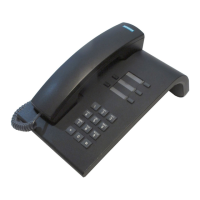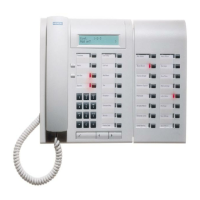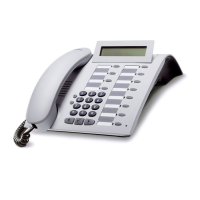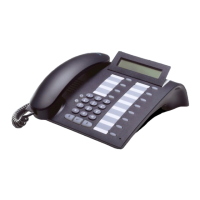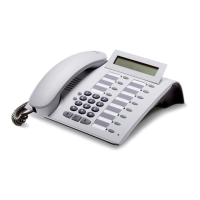Do you have a question about the Siemens Optiset E Standard and is the answer not in the manual?
Guide on interpreting symbols and procedures in the manual for effective use.
Explanation of how telephone screen messages are displayed and interact with functions.
Statement of device conformance to EU guideline 1999/5/EG.
Information regarding the telephone's manufacturing process and environmental impact.
Selecting and executing functions directly from the idle telephone interface.
Using the Program/Service menu to find and activate specific functions.
Directly accessing saved functions by pressing programmed keys.
Core telephone functions available through various interaction methods.
Specialized functions for teamwork and administrative roles.
Tips for optimizing usage, such as faster dialing and handling busy lines.
Step-by-step guide to answer incoming calls using the telephone handset.
Instructions for answering calls hands-free using the speakerphone.
Allowing other people in the room to join an ongoing call via speakerphone.
Procedure to switch an active call from handset to speakerphone.
Procedures for dialing numbers after lifting the handset.
Procedures for dialing numbers without lifting the handset.
Entering numbers before dialing and correcting them if necessary.
Preventing your station number from appearing on external displays.
Initiating a call to a second party while the first is on hold.
Setting up and managing multi-party conference calls.
Redirecting an ongoing call to another person or extension.
Temporarily storing a call to be retrieved later from any telephone.
Accessing and managing a list of incoming calls.
Redialing the last three external numbers that were dialed.
Accessing and dialing numbers from the system's internal directory.
Utilizing station and system speed-dial numbers for quick calling.
Viewing call charges for the current or last conducted call.
Assigning external calls to specific projects using account codes.
Storing a request for a callback when a line is busy or unanswered.
Procedure for connecting to a waiting call when the line is busy.
Joining an occupied line by overriding the current call.
Setting the loudness level for incoming call ring signals.
Optimizing speakerphone audio based on the room environment.
Securing the telephone to prevent unauthorized access during absence.
Setting up and managing a Personal Identification Number (PIN).
Storing frequently dialed numbers to programmable keys.
Saving speed-dial numbers for quick access and dialing.
Programming specific telephone functions to keys for easy access.
Interpreting LED status indicators for various saved telephone functions.
Performing self-tests on telephone hardware and core functions.
Verifying which functions are programmed on specific telephone keys.
Forwarding internal or external calls to different destinations dynamically.
Forwarding all calls to a specific station during non-business hours.
Forwarding calls via carrier network and multiple subscriber numbers.
Sending short text messages to other system users.
Recording a message for internal callers when away from the desk.
Allowing others to use your telephone for outgoing calls.
Transferring call number and settings to another telephone.
How team members use trunk keys for call management.
Steps to answer incoming calls using designated trunk keys.
Managing calls on hold using trunk keys for retrieval.
Managing multiple active calls on different trunks.
Activating and deactivating group call features for users.
Picking up calls intended for other team members.
How incoming calls are distributed to agents based on availability.
Procedures for leaving hunt groups or group calls.
Activating/deactivating call forwarding from other AllServe phones.
Defining other phones as night answer points via AllServe.
Switching relays on/off for controlling facilities like door openers.
Instructions for labeling telephone and key module keys with pre-cut cards.
Using PC software for convenient labeling of telephone keys.
Information on how to order additional copies of the operating manual.
List of available accessories for customizing telephone features.
Guidelines for cleaning and maintaining the telephone unit.
Basic steps for diagnosing and resolving common telephone issues.
Explanations and recommended responses for screen error messages.
Information on who to contact for unresolved telephone issues.
| Display | No |
|---|---|
| Speakerphone | Yes |
| Volume Control | Yes |
| Headset Port | Yes |
| Handsfree | Yes |
| Keypad | Yes |
| Keys | 12 |
| Power Supply | From telephone system |
| Weight | 800 g |


